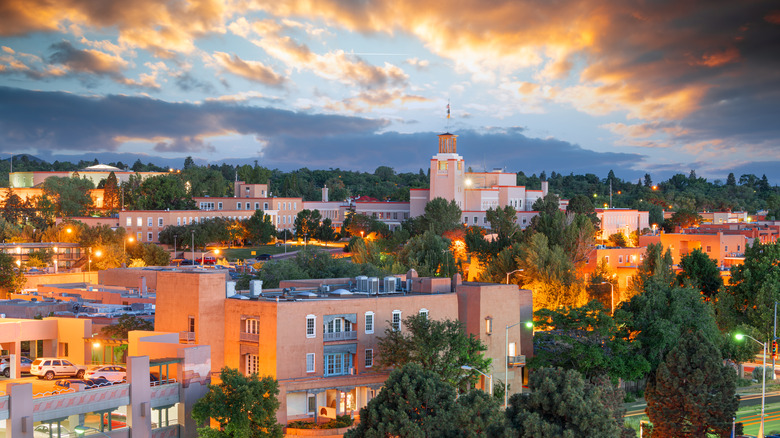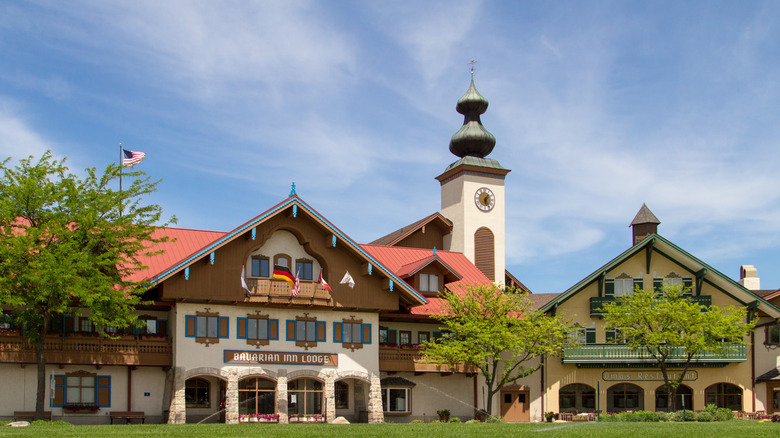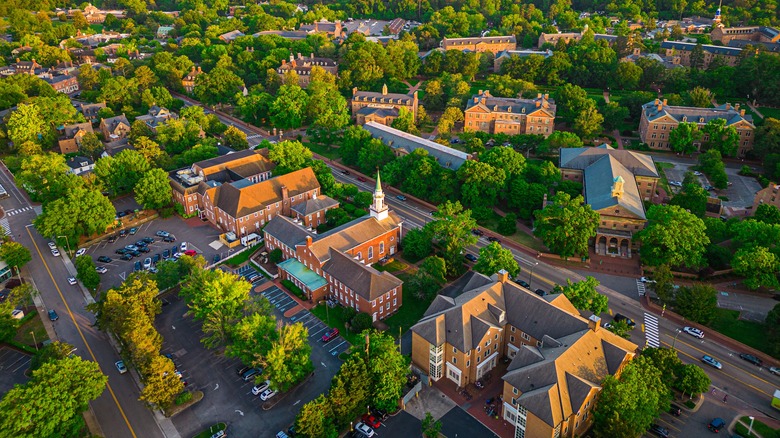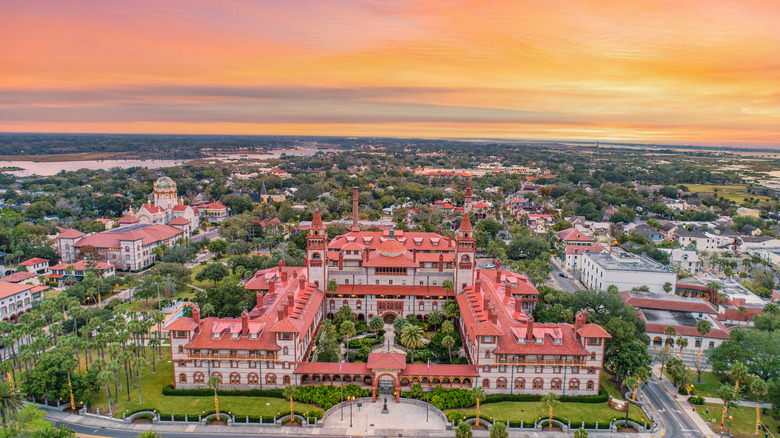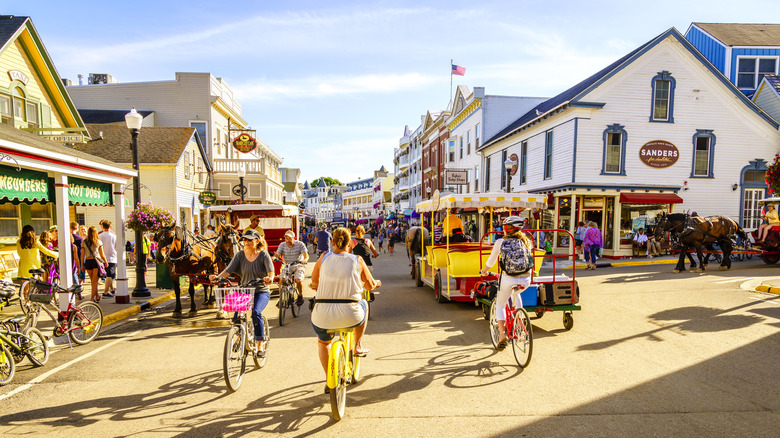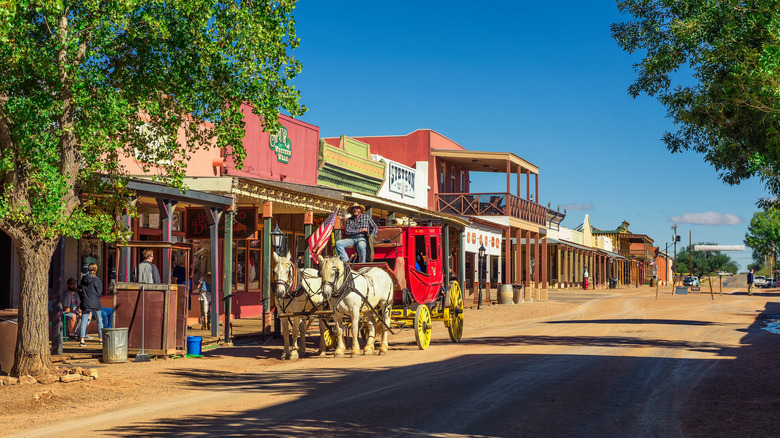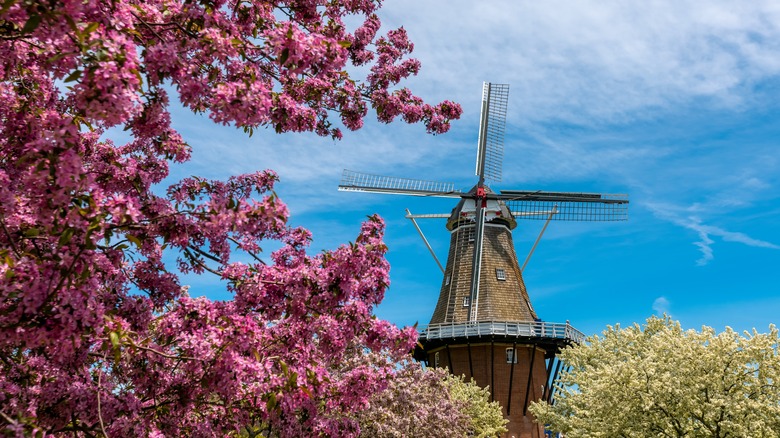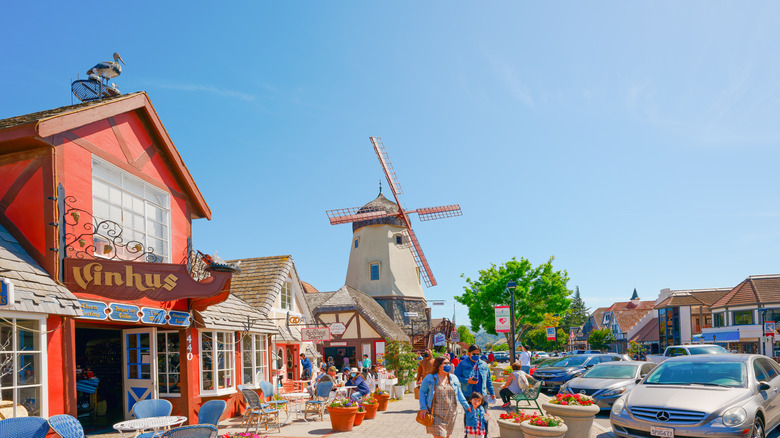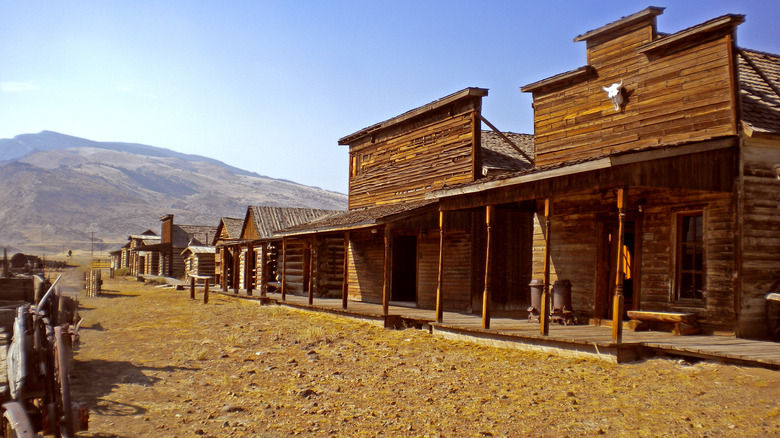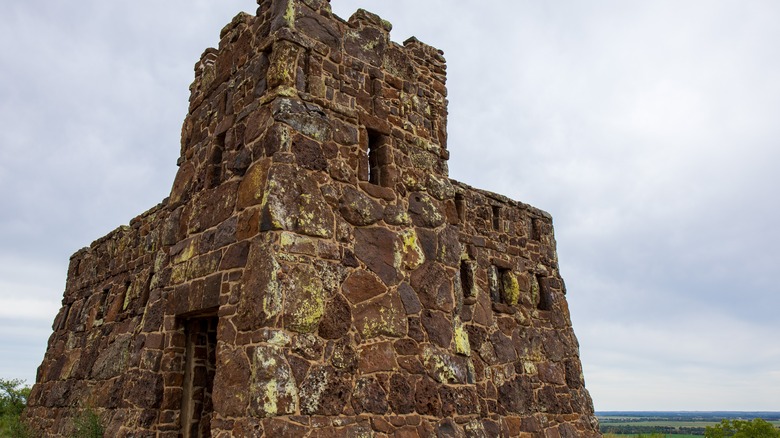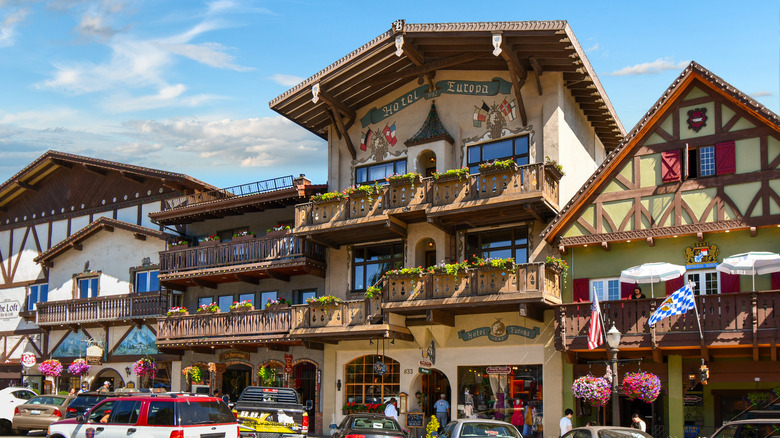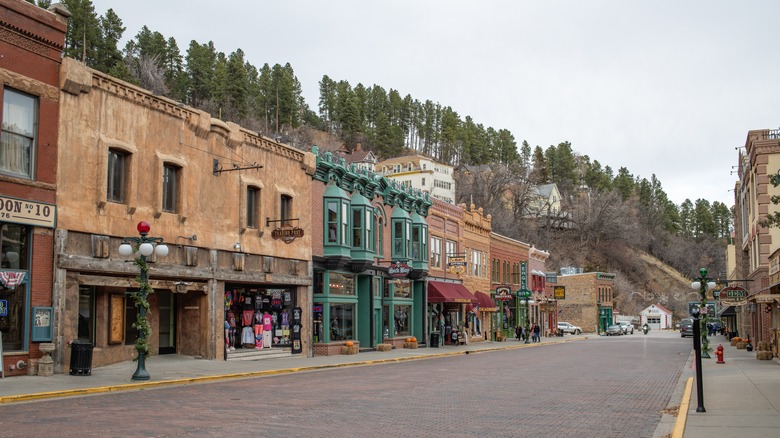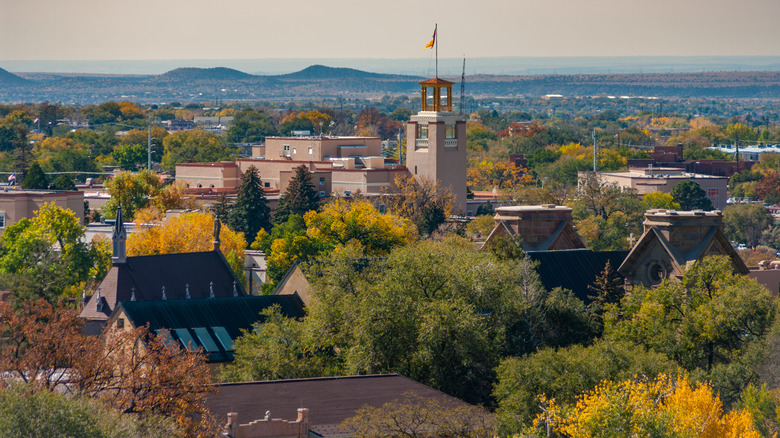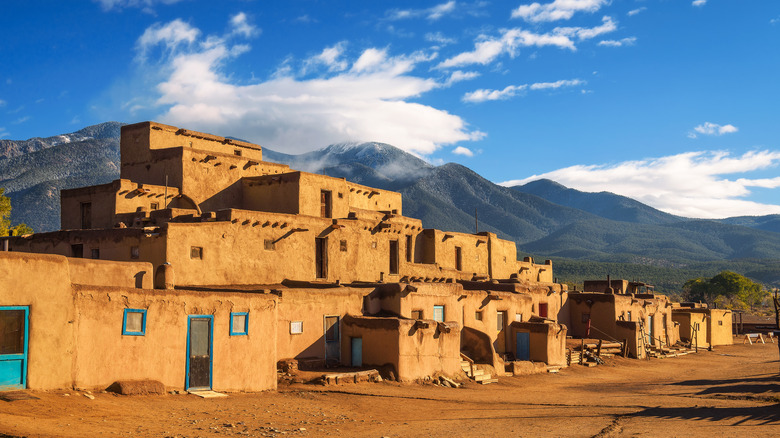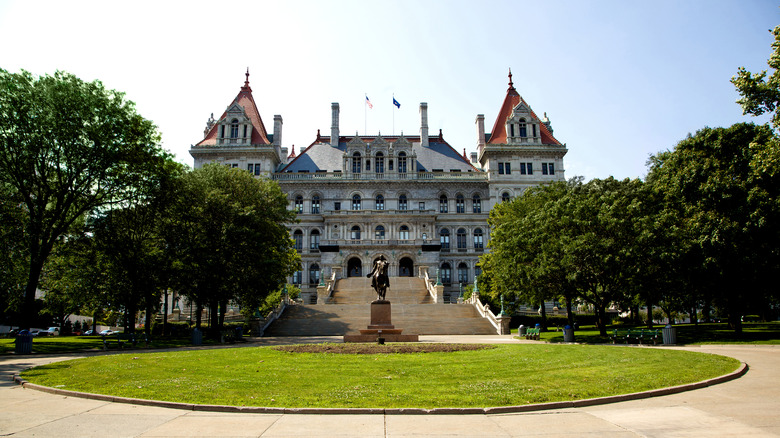15 Small Towns In America That Look Stuck In Time
Travelers meandering the United States will come across all types of towns. Some of the best ones to find, however, are the ones that you won't find anywhere else. There are a handful of towns strewn throughout the country that look like they've been zapped from another time and place. We don't yet have time travel technology, though nothing is stopping us from getting a taste of the past, thanks in part to small-town America.
A few of these, like Williamsburg, are probably places you've heard of, but several others may be entirely new, like Mackinac Island or Lindsborg. They aren't boring just because they're practically stopped in time. We also specifically chose these locations to provide a wide variety of atmospheres, activities, and aesthetics. Although some of these are small cities rather than towns, they all have a population of less than 100,000. From the bygone days of the Wild West to romantic snapshots from Sweden, these dreamy destinations will surprise you. One of these time-stopped spots may even become your new favorite place.
Frankenmuth, Michigan
Also known as "Little Bavaria," Frankenmuth, Michigan is an utterly charming destination. Rooted in the area's deep German heritage, Frankenmuth has taken on the appearance of a quaint Bavarian town. Drenched in German language, cuisine, and design, you'll feel transported across the pond to the Bavarian mountains.
Founded in 1845 by a group of German immigrants, Frankenmuth adapted the heritage of its founders. Even over 175 years later, the town still embodies much of what its founders infused into it. Clearly, its dedication to the past Bavarian culture resonates with travelers since Frankenmuth is a top vacation spot in Michigan.
While the town has changed through the years, it has remained steadfast to elements of its past. Residents built a dam and mill in 1847, and one of the town's wool mills is the oldest one in continuous operation in the state, dating back to 1894. Frankenmuth is known historically for its milling, though the modern-day town is also famous for housing the world's largest Christmas store and its chicken dinners.
Luckenbach, Texas
One thing is for sure about Luckenbach, Texas: Its days of population booms are truly in the past. With a population of three residents, this is the smallest of our time capsule towns. But, while its everyday population is small, its reputation is mighty. Like the aforementioned Frankenmuth, Luckenbach was also founded by Germans, becoming a trading post in 1849.
The literal one-horse town feels stuck in time because its central architecture is a historic saloon, which is still in operation, along with a dance hall. Although it's totally abandoned elsewhere, the town's central meeting spot is still the place to be — like it was over a hundred years ago. Not to mention that when you are hanging out at the saloon, the surrounding trees are all over 500 years old, giving the area an even more historical feel.
Even after spending just a little time in Luckenbach, you'll feel compelled to drink some moonshine in the starlight. You'll feel as though you've stepped back into a less hostile Wild West motif – less rootin' and more shootin' the breeze.
Williamsburg, Virginia
A town stuck in time intentionally, Williamsburg, Virginia, is the world's largest U.S. history museum. It has intentionally remained in the scope of Colonial America to demonstrate how life was. Reenactors walk the streets in Colonial garb to add to the time travel illusion. You can learn how to do all kinds of things like spinning yarn and whittling, which can help you gain a greater appreciation for modern advancements.
Even beyond the more obvious historical elements of Williamsburg, it's just a fascinating place to be. As one of the country's first planned cities, it gives a glimpse into how early Americans developed settlements near the turn of the 18th century. And because it's also home to the College of William & Mary, you can walk in the footsteps of some of the country's early leaders. Alumni of the college include Thomas Jefferson, James Monroe, and John Tyler.
St. Augustine, Florida
While New England gets a lot of attention for its historical ties to early America, St. Augustine's history actually goes back further than that. It was founded in 1565 – over 50 years before the Pilgrims arrived. Because of that, the Spanish settlement was the first in the country that survived.
Given its Spanish heritage, St. Augustine is full of colorful architecture influenced by Spanish settlers. Walking the cobblestone streets here will snap you back over 400 years. You can even visit the city's most famous historic landmark, the Castillo de San Marcos. This Spanish fort was built between 1672 and 1695 and is the oldest masonry fortress in the country.
Nicknamed "The Ancient City," it's easy to see how the country's oldest city transports you back in time. Beyond its historical architecture, other city highlights like the St. Augustine Pirate and Treasure Museum and the Lightner Museum will further demonstrate the area's rich history.
Mackinac Island, Michigan
Film nerds will appreciate the inclusion of Mackinac Island, Michigan on this list. That's because Christopher Reeve's 1980 time-traveling film "Somewhere in Time" was filmed partly on this island seemingly stopped in time. However, anyone who visits Mackinac can experience its 1800s charm as the island (which has banned cars) remains firmly planted in the Victorian era. Along with its historical charm, visitors can also enjoy Mackinac Island's fudge — it's to die for.
Since cars aren't allowed, you can get around the island via horse-drawn carriage, on foot, or bicycle. Island guests can also stay in Victorian-era hotels to get a feel for life on the Midwestern island near the turn of the 20th century. Beyond its intentional attachments to the past, Mackinac is also home to several of the oldest buildings in the state, which date back even further.
You can also visit Fort Mackinac, which was the site of the first domestic skirmish of the War of 1812. The fort still maintains 14 original buildings. Visitors can see into the island's wartorn past by attending one of the daily reenactments held here.
Tombstone, Arizona
A classic Wild West town that hasn't been abandoned, Tombstone, Arizona, is the perfect combination of activity and historical authenticity. Maintained by its 1300 residents, Tombstone hasn't gone the way of the ghost town — despite the irony of its name. Its streets are still entrenched in the aesthetics of cowboys and shootouts. Allen Street, in particular, is Tombstone's pièce de résistance and the town's main thoroughfare.
Because so many Old Western towns have been abandoned, it makes Tombstone all the more vital for history. The architecture here is special as it accurately reflects the Old West, and Tombstone was the site of the famed Gunfight at the O.K. Corral.
It's not uncommon to see reenactors take to the street to demonstrate an old-fashioned gunfight, and visitors can learn more about the Western icon Wyatt Earp by visiting his home, which is now a museum. However, a visit to Tombstone wouldn't be complete without visiting the Boothill Cemetery to see some of the town's bygone residents, including Three-Fingered Jack Dunlap, who was a famed train robber, Marshal Fred White, and the cowboys killed at the famed O.K. Corral shootout.
Holland, Michigan
To the surprise of none, Holland, Michigan, is deeply informed by the culture of the Dutch. It was settled in 1847, though the city was devastated by a huge fire in 1871. Think turning windmills and vibrant tulips. Holland wholly embraces the Dutch culture by hosting annual events like the Tulip Time Festival each May.
Beyond the cultural aesthetics of the town, some attractions bring you even deeper into a simpler time. At Neli's Dutch Village, you can venture through a recreated Dutch village, do some shopping, experience Dutch cultural events, and even hang out with some goats.
The star of the town is undoubtedly The Windmill Island Gardens. Here, you'll find the 250-year-old De Zwaan windmill, which was shipped from The Netherlands in the 1960s. This Dutch village area, as with Neli's, transports you back a few centuries to The Netherlands of another time.
Solvang, California
Although Solvang is represented with the visage of a windmill as well, this town harkens back to a different heritage. Founded by Danish immigrants in 1911, the Californian town has Denmark in its heart. While it is on the younger side of the places we've listed so far, it still feels transporting to explore a town so entrenched in traditional Danish culture.
Along the city's Copenhagen Drive, buildings look like they've been plucked straight from Denmark. Feeling as it did at the turn of the 20th century, Solvang is full of Danish establishments like bakeries and handicraft shops. You can also visit the Old Mission Santa Inés, which predates Solvang by over a century. This Spanish Mission adds to the historical significance of the place.
If you want a more traditional yuletide celebration, the annual Julefest is held from the end of November through the beginning of January. These festivities will help you bring some of your Dickensian Christmas inclinations to the Danish surroundings.
Cody, Wyoming
Here's the thing about locations focused on history: Sometimes the history isn't limited to what actually happened at that place. Cody, Wyoming, is a terrific example of this. Founded by Colonel William F. "Buffalo Bill" Cody, the town exemplifies notions of the Wild West. That said, it was incorporated as Cody in 1901 to be a tourist town. Since it's right by Yellowstone National Park, Cody wanted to create a tourism hot spot for Yellowstone visitors.
Visitors can get a sense of the Wild West outside of a ghost town. Cody is referred to as the "Rodeo Capital of the World," and the town is home to the Buffalo Bill Center of the West. Cody is unique, as you can experience a Wild West style without sacrificing access to other amenities. If you want a deeper sense of being lost in time, stop by Old Trail Town, a museum where you'll find old-timey saloons, homes, and artifacts of the Wild West.
Lindsborg, Kansas
If you've never heard of a Dala horse, you'll sure know them after a visit to Lindsborg, Kansas. These charming Scandinavian horses are vibrantly painted and can be seen all over the city. You may even get a Dala horse-shaped cookie if you stay at the Dröm Sött Inn. Founded by Swedish immigrants in 1869, Lindsborg retained much of that incredible culture. There's even a castle that you can visit here to get incredible views of the area.
Reflective of its Swedish heritage, the downtown architecture is rich and colorful. As you count the members of the Wild Dala Herd throughout the city while strolling the cobblestone roads, it's hard not to fall in love with Lindsborg. Even if it isn't as old as some of the other spots listed, its rich cultural connections and historic sites, like the 1898 Historic Flour Mill, will enhance the significance of visiting.
Leavenworth, Washington
Leavenworth, Washington, exemplifies the notion of going back in time. This town is not to be confused with Leavenworth, Kansas, which is representative of the Old West. While the Washington town wasn't initially fashioned after a Bavarian village, the transformation began in the 1960s, inspired by the area's alpine hills. Like other Bavarian-styled towns, Leavenworth feels forgotten to time because of the region it reflects. The Kingdom of Bavaria folded into Germany in 1918, so towns inspired by Bavaria tend to feel stuck in that particular place in time.
Leavenworth's transformation went above and beyond, and city planners gave the entire town a full makeover. It really does look like a Bavarian town in the Alps. Walking past the Fachwerk-styled buildings in Leavenworth, you may find yourself surprised to hear people speaking English. The aesthetic is that realistic! Despite the city's new look only being a few decades old, the dedication to the theme, even for the local Starbucks, is incredible.
Deadwood, South Dakota
Brought into pop culture thanks to the HBO series of the same name, Deadwood, South Dakota, is a gold nugget for history travelers. This gold rush town embodies all things Wild West and mining histories. Not only is it a gold rush town, Deadwood is a gold rush town that helped set off the phenomenon. Famed Wild West names like Calamity Jane and "Wild Bill" Hickok also spent a fair amount of time in Deadwood — they're both also buried here.
Not only do parts of Deadwood still look like set pieces from the gold rush era, the Deadwood Alive troupe reenacts events in the streets. You can even witness the reenactment of Wild Bill's assassination. Although areas of the city are very modern, there are still a lot of historical sites to see in Deadwood. To fully immerse into the gold rush life, you can explore the Broken Boot Gold Mine, visit the graves of Wild West icons at Mount Moriah Cemetery, and stay in the Historic Bullock Hotel.
Santa Fe, New Mexico
Like St. Augustine in Florida, Sante Fe also predates the Pilgrim's voyage to the New World. As the oldest capital city in the country and the oldest European settlement west of the Mississippi River, Santa Fe's origins as a Spanish settlement are obvious in the architecture throughout the city.
Part of what makes Sante Fe so unique is that much of its iconic architecture is unlike anything you'll see in other American cities. The city is a mix of Pueblo, Greek Revival, and Territorial Revival styles. These mixed styles create a historical city informed by Native American, Mexican, and Spanish influences.
The vintage veneer of the city is also protected per governmental regulation. A law from 1958 decreed that any buildings erected or redone in historic areas must be made in a Spanish Territorial or Pueblo style. This is part of what keeps Sante Fe placed firmly in the past.
Taos, New Mexico
While Taos, New Mexico, was only incorporated in 1934, its history goes back centuries. The area's most significant historic landmark, the Taos Pueblo, dates back to the 1500s. The Taos Pueblo inspired the Pueblo Revival style you see throughout the West, particularly in New Mexico. You'll see this storied architectural style throughout Taos, which gives it an air of history similar to that of Sante Fe. The Taos Pueblo is also a UNESCO World Heritage Site.
The historic downtown plaza area dates back to 1796 when the King of Spain allocated land for 63 families to live here. But many of the historic buildings in and around the plaza have been damaged or destroyed since. Now, the plaza mostly dates back to the 1930s, still giving the downtown a historic bent even if that history is a few centuries removed.
Albany, New York
As one of the oldest cities in the country, Albany, New York, is like an early American time capsule. Settlers arrived in the area in 1609; however, it wasn't until 1797 that Albany became the state capital. Beyond housing some incredible historic sites, Albany is also a place of invention. The telegraph, electric motor, and celluloid plastic were all created here, and Albany served as the point of departure for the first passenger railroad and long-distance flight.
Fans of the musical "Hamilton" may like to know that the Schuler Mansion State Historic Site is located in Albany, and if you've ever wanted your own Schuyler sisters moment, this is it. Because Albany was, at one point, a major banking and transportation center for the United States, the picturesque architecture of the city is impressive — evident in the Renaissance and French Renaissance designs of the New York State Capital Building.
For a simpler view of past lives in Albany, make a stop at the nearby Mabee Farm Historic Site. The Dutch farm is over 300 years old and is a terrific juxtaposition of the intricate architecture you see elsewhere in the city.
